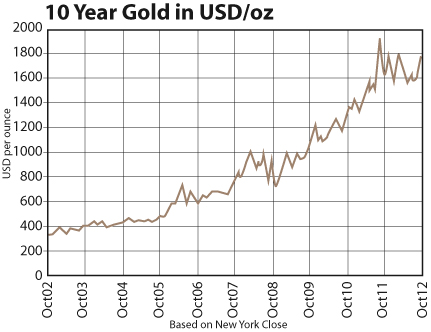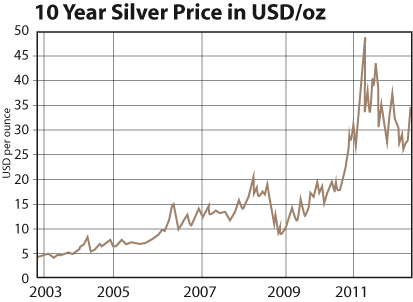So in that spirit, let's review the precious metals mail…
Gold and silver prices recently moved upward. Thus, the mailbox received questions about where precious metal prices are heading. "Will gold and silver prices keep moving up?" asked one reader.
"Do you think that gold prices will fall back?" asked another reader. "And when?" he wanted to know.
"Why shouldn't gold and silver just keep trading in the current range?" asked a third reader.
My tongue-in-cheek answer to all three questions is "Yes."
All kidding aside, we have to figure out how best to invest in gold and silver. You see, the past decade has been good for precious metals.
Let's start with a look at gold…

Look at the 10-year price trend. For more than a decade, we've lived with generally rising gold prices. This was certainly the case for the first years of the 2000s. And precious metal prices have risen strongly since I started writing Outstanding Investments in 2007.
As the chart shows, gold prices were in the $350 per ounce range about 10 years ago. When I came on board, in February 2007, gold traded in the $650 range. There was a price rise over the next year, and then a price swoon during the crash of 2008. People sold gold to raise fast cash. Gold is liquid and someone will always buy it — which makes for a strong eternal lesson.
From 2009 through the end of 2011, gold prices rose steadily, from the $900 range to, at one point, well over $1,800 per ounce. Then, in the first half of 2012, we had a price retreat. Now gold prices are up about 13% for the year, with almost 11% of that just in the third quarter.
Focusing on 2012, gold prices have bounced around between $1,600–1,750 per ounce. That range may annoy short-term traders, but in my view the spread is akin to background noise for long-term investors. I'll give away the ending to the story by telling you that I believe there's more upside coming to gold. Lots more.
Silver Trends
How about the 10-year trend for the price of silver? Let's start with the chart (below), which is similar to that for gold, although not exactly a match:

Let's discuss that last point, because I've had questions about it from readers. Unlike gold, silver is widely used in industries like chemicals and electronics, as well as jewelry and bullion. Thus, silver pricing is more sensitive to macroeconomic swings — something we saw all through the 2008–09 global crash and ensuing weak recovery.
To amplify that point, many industrial applications "consume" silver, in that the basic metal gets incorporated into compounds that don't recycle. For example, consider how many hundreds of millions of cellphones and computer keyboards have gone out with the trash into landfills over the past two decades. (C'mon. You know that you've tossed a few out!) Each item contained some amount of silver, as often as not a small amount in the nature of a fraction of an ounce.
By comparison with silver, one of the most heavily recycled metals in the world is lead (no pun intended). Just based on weight of materials alone, almost every car battery on the planet has enough value that people recycle the innards. Thus, lead recycling offers quite a contrast with many "throwaway" products that contain silver.
So as for the basic dynamics of silver prices? Over the past decade, silver prices have gone up and down during short time frames. That's what trading is all about. But the general trend has been up, up and up some more.
Currently, silver sells at about $35 per ounce, which is way up from $5 looking back 10 years. In 2012, we've had a nearly 25% rise in silver prices — almost all of that coming in the third quarter. Is there more to come? Probably, barring a global economic crash.
Yes, there were up and down periods for gold and silver, so timing matters to some extent. But generally, and overall, it's been good if you think long term.
Looking ahead, will gold and silver continue to preserve wealth? At the end of the day, how can we make some money?
Another Round of QE…
Let's start with the macro picture. In fact, let's start with the macro views of readers, whose emails lately reveal deep unease about the economy. One big source of worry is the Federal Reserve's recent announcement about another round of "quantitative easing" (QE3). Basically, the Fed will keep interest rates super-low, while buying mortgage-backed securities far into the future.
Common concerns about QE3 include this from a reader: "The Fed is bailing out the banks, again! But what about strangling me and my savings? The banks make money off the Fed, and in return I get almost no interest — a fraction of a percent. I get squeezed from both ends, once by inflation and again by low interest income."
Further along these lines, another reader wrote to say, "What's going on with the dollar? I just keeps on declining in value. It seems like I pay more and more to buy less and less."
The way I see it, that's been the case since the creation of the Federal Reserve in 1913!
At root, QE3 looks like the Fed is just throwing up its hands — at least figuratively. In essence, with QE3, the Fed has announced that it'll let inflation roll for a while. That, and the Fed will further destroy capital with long-term low interest rates.
From the outside looking in, it appears that the Fed has all but given up on the American political class. I get it. For the past couple of generations, U.S. political leadership simply was not serious about the nation's money, let alone maintaining the foundations of national wealth. Even (allegedly) conservative former Vice President Dick Cheney once said, "Deficits don't matter." Oh, really?
What's left for the Fed to do? Right now, the Fed is playing its last cards — "jokers," some might opine — via QE3. The Fed rationale is, evidently, that the "political" part of the national government can't harmonize tax receipts with overall expenses. So the unelected, "independent" Fed will open the currency spigots and inflate away!
It leads to the question of whether or not the U.S. is committing national economic suicide. One reader summed it up thus: "There's no political mileage in cutting spending. Not for Republicans. Not for Democrats. There's no political consensus to raise taxes, either, not that the economy could stand it. I feel like I'm riding a train that's about to fall off the tracks, into a canyon, and I can't get off."
Another reader to sums things up pretty well with this comment: "It's all out of my control. I don't know exactly what to do, so I'm in cash, gold and silver. I have shares in a few mining plays, and a couple oil companies. But mostly cash, gold and silver."
I couldn't have said it better myself.
That's all for now. Thanks for reading.
Byron W. King
The Daily Reckoning



























































